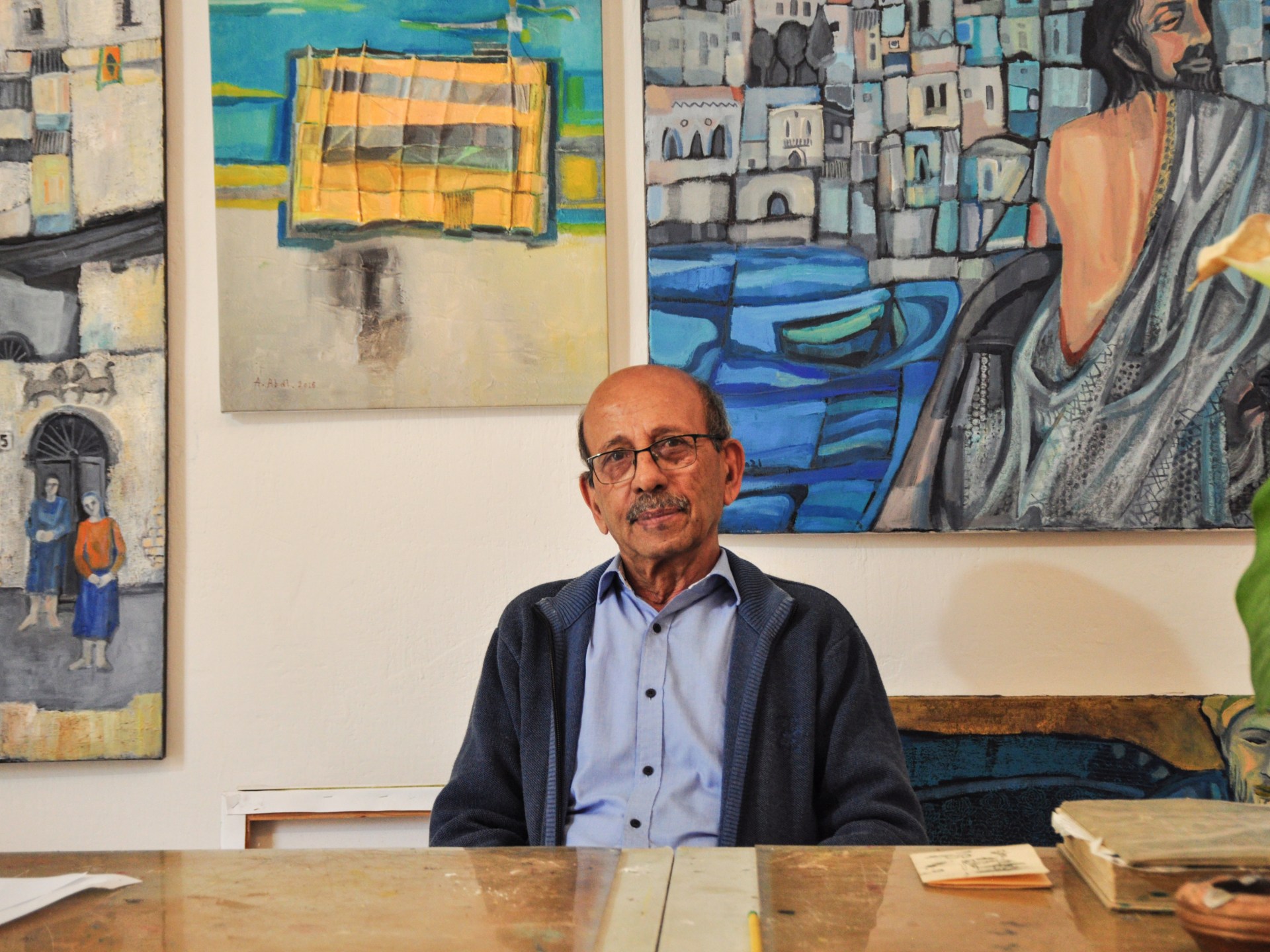Art
Photos: Memories of Nakba inspire Palestinian artist’s work

Wadi Nisnas, Haifa – Visual artist Abed Abdi was expelled from Haifa – a major port city on the Mediterranean Sea – along with tens of thousands of fellow Palestinians by Zionist militias in 1948.
Memories of displacement and dispossession that started at age six inspire the art Abdi produces even today, at 81 years of age.
“Those scenes are very painful,” Abdi tells Al Jazeera from his art studio, located at the edge of the neighbourhood of Wadi Nisnas on the northern outskirts of Haifa.
“My memory of those moments is like a treasure to me,” added Abdi – a soft-spoken, meticulous man. “I remember the masses of people at the Haifa port. I remember the suffering of the people.”
On April 22, 1948, three weeks before Israel was declared a state, Abdi was forced to flee from the neighbourhood of Wadi Salib in Haifa with his mother and four siblings due to intense shelling by Zionist militias and attacks on residents.
More than 750,000 Palestinians were forcefully displaced from their homelands as Zionist militias went on a rampage, killing Palestinians and destroying their society and homelands in 1948.
At least 110 Palestinian men, women and children were slaughtered in the Palestinian village of Deir Yassin on April 9, 1948, and Zionist militias killed 60 to 70 Palestinians in the Balad al-Shaykh village, 7km (4 miles) east of Haifa city months prior.
Palestinians observed the 75th anniversary of the organised and violent ethnic cleansing of Palestine – which is marked as Nakba, or catastrophe – on May 15, 2023.
“Most of Haifa’s residents took to the port for shelter, thinking that it could save them. Even if they would be away for a week or two, they would be back,” says Abdi, who returned to his homeland three years later.
“Some people carried their mattresses with them. My mother took cooking tools such as her mortar, even though it was heavy. We took it and came back with it. She also asked someone to carve her name into one of her pots that she took with her,” Abdi continues.
His father managed to remain in Haifa during the cataclysmic events. After three years in refugee camps across neighbouring Lebanon and Syria, Abdi, his mother and three of his siblings became one of the few Palestinians allowed to return to their city for family unification in 1951.
Between December 1947 and April 1948, the Zionist forces expelled more than 95 percent of Haifa’s Palestinian residents. Originally a city of some 75,000 Palestinians, only 3,000 to 4,000 of them remained after the Nakba. The rest became refugees, mainly in neighbouring Lebanon and Syria, and they are barred from returning to this day.
Those who remained were concentrated in the neighbourhood of Wadi Nisnas and prevented from returning to their homes or retrieving their property.
“Our suffering continued – we returned to hardship and a hostile environment. The homes and properties of the Abdi family owned were all confiscated. My father moved into his aunt’s house, the ownership of which also went to the state,” he says.
“I was in a situation where I realised it was critical for me to activate my visual memory,” says Abdi. During his time in refugee camps, he recalled one attempt to displace his family again.
“I remember, and my sister Zahra remembers, there was an attempt to evict us or displace us once again, in a truck, to Baghdad. We escaped from the camp and we went to my sister Lutfiyeh’s house in Damascus.”
At 22, Abdi moved from Haifa to Germany, where he was accepted into a visual arts school. Upon his return in 1972, he found that “there were few Palestinian artists”, he says. “I was in an environment where people were struggling for bread, not for creativity and nonessentials.”
Abdi worked as the chief graphic designer and illustrator of Al-Ittihad newspaper based in Haifa and Al Jadid literary journal – two key publications in Palestinian society at the time – for more than a decade, starting in 1972.
He drew illustrations and prints for notable names in the Palestinian literary scene at the time, including Emile Habibi, Toufiq Zayyad, Samih al-Qassim, Mahmoud Darwish and Salman Natour.
Besides producing countless pieces of art exhibited around the world, Abdi also gave art courses and workshops in Palestinian towns across Israel including Shefa-Amr, Kufr Yasif and Daliyat al-Carmel.
“I work towards creating a new cadre of Palestinian artists,” says Abdi, explaining, “It is important the new generations understand fully the truth of our expulsion from our city Haifa in 1948.”

Art
Ukrainian sells art in Essex while stuck in a warzone – BBC.com
[unable to retrieve full-text content]
Ukrainian sells art in Essex while stuck in a warzone BBC.com

Source link
Art
Somerset House Fire: Courtauld Gallery Reopens, Rest of Landmark Closed
The Courtauld Gallery at Somerset House has reopened its doors to the public after a fire swept through the historic building in central London. While the gallery has resumed operations, the rest of the iconic site remains closed “until further notice.”
On Saturday, approximately 125 firefighters were called to the scene to battle the blaze, which sent smoke billowing across the city. Fortunately, the fire occurred in a part of the building not housing valuable artworks, and no injuries were reported. Authorities are still investigating the cause of the fire.
Despite the disruption, art lovers queued outside the gallery before it reopened at 10:00 BST on Sunday. One visitor expressed his relief, saying, “I was sad to see the fire, but I’m relieved the art is safe.”
The Clark family, visiting London from Washington state, USA, had a unique perspective on the incident. While sightseeing on the London Eye, they watched as firefighters tackled the flames. Paul Clark, accompanied by his wife Jiorgia and their four children, shared their concern for the safety of the artwork inside Somerset House. “It was sad to see,” Mr. Clark told the BBC. As a fan of Vincent Van Gogh, he was particularly relieved to learn that the painter’s famous Self-Portrait with Bandaged Ear had not been affected by the fire.
Blaze in the West Wing
The fire broke out around midday on Saturday in the west wing of Somerset House, a section of the building primarily used for offices and storage. Jonathan Reekie, director of Somerset House Trust, assured the public that “no valuable artefacts or artworks” were located in that part of the building. By Sunday, fire engines were still stationed outside as investigations into the fire’s origin continued.
About Somerset House
Located on the Strand in central London, Somerset House is a prominent arts venue with a rich history dating back to the Georgian era. Built on the site of a former Tudor palace, the complex is known for its iconic courtyard and is home to the Courtauld Gallery. The gallery houses a prestigious collection from the Samuel Courtauld Trust, showcasing masterpieces from the Middle Ages to the 20th century. Among the notable works are pieces by impressionist legends such as Edouard Manet, Claude Monet, Paul Cézanne, and Vincent Van Gogh.
Somerset House regularly hosts cultural exhibitions and public events, including its popular winter ice skating sessions in the courtyard. However, for now, the venue remains partially closed as authorities ensure the safety of the site following the fire.
Art lovers and the Somerset House community can take solace in knowing that the invaluable collection remains unharmed, and the Courtauld Gallery continues to welcome visitors, offering a reprieve amid the disruption.
Art
Sudbury art, music festival celebrating milestone

Sudbury’s annual art and music festival is marking a significant milestone this year, celebrating its long-standing impact on the local cultural scene. The festival, which has grown from a small community event to a major celebration of creativity, brings together artists, musicians, and visitors from across the region for a weekend of vibrant performances and exhibitions.
The event features a diverse range of activities, from live music performances to art installations, workshops, and interactive exhibits that highlight both emerging and established talent. This year’s milestone celebration will also honor the festival’s history by showcasing some of the artists and performers who have contributed to its success over the years.
Organizers are excited to see how the festival has evolved, becoming a cornerstone of Sudbury’s cultural landscape. “This festival is a celebration of creativity, community, and the incredible talent we have here in Sudbury,” said one of the event’s coordinators. “It’s amazing to see how it has grown and the impact it continues to have on the arts community.”
With this year’s milestone celebration, the festival promises to be bigger and better than ever, with a full lineup of exciting events, workshops, and performances that will inspire and engage attendees of all ages.
The festival’s milestone is not just a reflection of its past success but a celebration of the continued vibrancy of Sudbury’s arts scene.

-

 News14 hours ago
News14 hours agoB.C. to scrap consumer carbon tax if federal government drops legal requirement: Eby
-

 Sports15 hours ago
Sports15 hours agoLawyer says Chinese doping case handled ‘reasonably’ but calls WADA’s lack of action “curious”
-

 News14 hours ago
News14 hours agoA linebacker at West Virginia State is fatally shot on the eve of a game against his old school
-

 Sports9 hours ago
Sports9 hours agoCanada’s Marina Stakusic advances to quarterfinals at Guadalajara Open
-

 News14 hours ago
News14 hours agoHall of Famer Joe Schmidt, who helped Detroit Lions win 2 NFL titles, dies at 92
-

 News15 hours ago
News15 hours agoRCMP say 3 dead, suspects at large in targeted attack at home in Lloydminster, Sask.
-
News24 hours ago
Local Toronto business story – Events Industry : new national brand, Element Event Solutions
-

 News15 hours ago
News15 hours agoProvinces decry Ottawa’s plan to resettle asylum seekers across the country



















